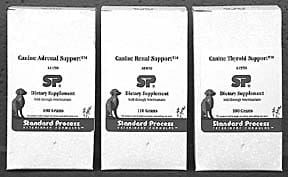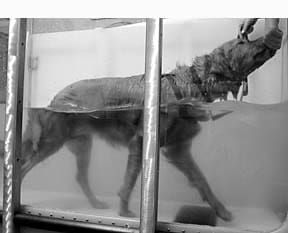Can you imagine a food so easy to assimilate that even the most impaired digestive tract absorbs it on contact?
Now imagine that this food speeds the healing of wounds throughout the body, repairs digestive organs, alleviates nausea and vomiting, stops diarrhea, supports the liver during detoxification, reduces the side effects of chemotherapy and possibly helps prevent or reverse cancer, prevents toxemia in pregnancy, rescues newborns from Fading Puppy Syndrome, helps elderly dogs maintain their strength and stamina, helps all dogs recover from chronic and acute illness, stimulates hair growth, reduces urinary tract infections, reduces or eliminates allergic reactions, prevents hot spots, improves mobility, reduces pain, and even enhances the effectiveness of homeopathy and herbal therapies.

That miracle food exists, and dogs love its taste. They should. It’s an odoriferous powder made from fermented fish.
Seacure was Invented to Combat Hunger
Forty years ago, scientists at the University of Uruguay, who were searching under the direction of the U.S. National Academy of Sciences for a way to feed starving children, perfected a fermentation technology that predigested fish, creating a highly absorbable protein supplement. Fresh, deep-sea whitefish fillets were broken down by marine microorganisms, then dried to create a fine powder.
During the 1970s and 1980s, physicians in Uruguay and adjacent countries used the formula to save the lives of thousands of premature, underweight, or malnourished infants. In clinical studies, these infants showed significant improvement in weight and immunity factors (globulin and gamma globulin levels) within 30 to 60 days. No premature infants receiving the fish formula developed edema. When other infants developed edema, use of the formula caused its disappearance within 48 to 72 hours.
Uruguayan researchers tested a combination of two-thirds mother’s milk and one-third fermented fish powder for premature infants and found that the fish powder improved assimilation and weight gain. The researchers reported a “most remarkable” disappearance of dysergia (lack of motor control due to defective nerve transmission) in cases of dystrophy. When given to pregnant women, the supplement was also found to be very effective in promoting normal birth weights (preventing low birth weights).
When the fish supplement was fed to babies who were allergic to milk or had other food allergies, their allergic reactions disappeared, along with symptoms such as acute and chronic diarrhea or blood-based immune disorders. Soon physicians were documenting health benefits for patients with all kinds of illnesses. However, when the formula’s key developer died, production stopped.
Donald G. Snyder, Ph.D., then director of a Fisheries Research Laboratory at the University of Maryland and a member of a U.S. National Research Council committee on protein supplements, formed a partnership to obtain the technology and produce the powder, which he named Seacure®.
Seacure, which is made from Pacific whiting caught in the Pacific Northwest, contains beneficial omega-3 fatty acids and other fish nutrients, but its amino acids and peptides (the fundamental constituents of protein) are its primary healing ingredients.
(EDITOR’S NOTE: Proper Nutrition, Inc. is the maker of Seacure® and licences its use in other supplements. Still other supplement makers manufacture and sell similar biologically hydrolyzed whitefish products. All of the product studies and research referred to in this article were conducted using Seacure®.)
Seacure is a Different Kind of Protein
Most protein supplements sold in the United States contain ingredients that can be difficult to digest and assimilate, such as meat, animal skins, milk, eggs, or soy. Dr. Snyder (who recently passed away) felt these proteins were inferior sources for supplements.
“Often,” he explained, “these raw ingredients are contaminated or of low quality, such as rejected eggs or excess milk, or they are processed using harsh physical or chemical methods. Severe drying methods are often used, resulting in a deterioration in the final protein quality. And protein from the byproducts of processing may be of questionable value to begin with. The key thing is the quality of a supplement’s protein and the pre-digestion factor that makes it available to the body.”
All proteins are formed from long chains of compounds called amino acids. The body (both human and canine) can synthesize or manufacture some amino acids, but others are called essential because the body cannot manufacture them and they must be provided by protein in the diet. This use of the word “essential” can be confusing, for many amino acids are necessary for optimum health, but only those that must be provided by protein in food are called essential.
The World Health Organization established a model or ideal balance of the essential amino acids (isoleucine, leucine, lysine, methionine, cysteine, phenylalanine, tyrosine, threonine, tryptophane, and valine) in terms of milligrams of amino acid per gram of protein. The value of the protein provided by Seacure exceeds the model in every category. In addition, the quality of its raw materials exceeds that of other protein supplements, and its assimilation requires no digestive effort from the dogs and people who take it.
Seacure for Dogs
At Proper Nutrition, Inc., the company he founded, Dr. Snyder worked closely with marketing director Barry Ritz in research and development. “We receive many reports from veterinarians,” says Ritz, “indicating that Seacure’s benefits are as dramatic for dogs as they are for people.”
For example, he explains, malnourished, premature puppies have no ability to handle intact, complex protein. Seacure’s predigested protein can literally save their lives. In addition, it nourishes growing puppies, adult dogs, and any animals with malabsorption problems, such as sick or elderly dogs.
“It is no exaggeration,” Ritz observes, “to say that any dog of any age can benefit from Seacure’s high-quality predigested protein. The results, which are cumulative, include everything from improved wound healing to a thicker, glossier coat; a calmer disposition; improved digestion; and improvements in coordination, stamina, range of motion, and athletic performance.”
According to Ritz, veterinarians and dog owners report that doses of 6 to 12 capsules a day cause shaved fur to grow back in record time, broken bones and other wounds to heal quickly, and ailments like allergies, diarrhea, and inflammatory bowel disease to improve or completely disappear. Even dogs with autoimmune disorders like lupus have regained their mobility and appetite. Some owners report pigment corrections or a reduction in an older animal’s gray hairs.
“Seacure also helps dogs with diabetic leg ulcers and other slow-healing wounds. It speeds recovery from surgery, bite wounds, cuts, abrasions, burns, pulled muscles, and sports injuries. Dogs in obedience or agility class are more attentive as well as more efficient in their movements. And dogs with arthritis or joint pain just keep improving,” Ritz says.
Most dogs tolerate Seacure well. Dogs with kidney disease, for which low-protein diets are often recommended, should not have a problem because Seacure is already predigested and does not add stress to the kidneys.
The levels of mercury contained in Seacure are below the threshold of detection in mercury toxicity tests, 0.01 parts per million.
Understanding Detoxification
In our polluted world, detoxification has become a health buzz word. Like people, dogs are said to benefit from supplements and dietary changes that stimulate the removal of chemical residues, stored toxins, and stagnant wastes.
But too-rapid detoxification can be painful as well as harmful. Symptoms such as nausea, vomiting, dizziness, confusion, overwhelming fatigue, and skin eruptions such as hot spots often accompany rapid weight loss, the switch from commercial pet food to a raw, home-prepared diet, the use of herbs and supplements that cleanse the liver and blood, the acute phase of any illness, treatment with conventional drugs, treatment for parasites, or exposure to environmental toxins.
We often forget that detoxification is an ongoing body process. It never stops. If the body receives the nutrients it needs to break down and remove waste products well, it maintains itself in a state of health. If the process is impaired, health suffers. Unfortunately, many if not most of America’s dogs are overwhelmed with the ongoing burden of detoxification.
During the first stage of detoxification, the body identifies and separates waste products and toxins from the blood and lymph. Water-soluble material that can be excreted goes to the kidneys. Dehydration complicates the detoxification process, which is why access to clean drinking water is so important for dogs.
In Phase I of detoxification, during which waste products are made water-soluble and sent to the kidneys, the liver uses antioxidants and key minerals such as vitamins A, C, and E, bioflavonoids, selenium, copper, superoxide dismutase (SOD), zinc, and manganese. In phase II, the liver needs glucuronic acid, sulfates from glutathione, acetyl-cysteine, and the amino acids taurine, arginine, ornithine, glutamine, glycine, and cysteine.
When a dog is deficient in either Phase I or Phase II nutrients, backups and spillovers occur. Partially processed toxins traveling through the bloodstream may find a home in fatty tissue, or they may stay in the blood, infect healthy tissue, and cause new illnesses.
Many herbs and supplements are recommended for canine detoxification support, but few address the body’s need for amino acids. Seacure not only fills that gap and reduces the symptoms of detoxification, but also literally heals damaged organs and improves the dog’s digestion. Like people, dogs can suffer from leaky gut syndrome. Tiny injuries to the intestinal wall cause it to become too porous, allowing large molecules of undigested protein, bacteria, and microorganisms to migrate from the digestive tract to the rest of the body, which stresses and impairs the liver, pancreas, and immune system. Leaky gut syndrome is associated with food sensitivities, allergies, hyperactivity, and autoimmune disorders.
Giving meat and other high-protein foods to dogs with leaky gut syndrome or other digestive disorders doesn’t help because the damage prevents the food from being completely digested and assimilated. Seacure doesn’t require digestion, so it allows digestive organs to rest while supplying the amino acids and peptides needed for tissue repair and recovery.
Even dogs who suffer from vomiting, chronic diarrhea, and wasting diseases can usually accept Seacure, which can be mixed with water and administered with a dropper or feeding syringe. Seacure is not yet available as a powder for the convenience of feeding dogs and cats, but most dogs are happy to swallow the capsules whole. Or, the capsules can be opened and the powder sprinkled over food or mixed with water.
Whether you make Seacure part of your dog’s everyday diet or use it for a short time to speed recovery from an illness or accident, Uruguay’s solution to Third World famine problems can help your dog lead a longer, healthier life.
Also With This Article
Click here to view “Favorite Remedies Revisited”
Click here to view “Supplements and NSAIDs for Dogs”
A regular contributor to WDJ, CJ Puotinen is also the author of The Encyclopedia of Natural Pet Care, Natural Remedies for Dogs and Cats, and several books about human health, including Natural Relief From Aches and Pains.















